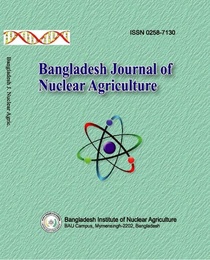EFFECT OF ROW SPACING AND DATES OF TRANSPLANTING ON YIELD PERFORMANCE OF KASALATH RICE MUTANT IN T. AMAN SEASON OF BANGLADESH
Abstract
Proper time of transplanting and appropriate spacing are necessary for standardization the yield potential of advance kasalath rice mutants in Bangladesh climatic condition.Thefield experiments were conducted at BINA Headquarters farm, Mymensingh in T. Amanseason of 2017 and 2018 to see the performance of two mutant lines of Kasalath under different dates of transplanting and spacings. In 2017, two advanced mutant lines namely RM-Kas-60(C)-1, RM-Kas-80(C)-1were evaluated along with BRRI dhan49 at three levels of spacing, viz. 20cm×15cm, 20cm×20cm and 20cm×25cm. Mutant line RM-Kas-60(C)-1 produced statistically higher grain yield (4.8 t ha-1) at 20cm×15cm spacing. In 2018, only RM-Kas-60(C)-1 was evaluated against Binadhan-11, at three row spacing (viz. 20cm×15cm, 20cm×20cm and 20cm×25cm) and three dates of transplanting such as July 15, July 30 and August 15. Among three transplanting dates, RM-Kas-60(C)-1 produced the highest grain yield of 4.86 t ha-1 at 20cm x 15cm spacing when transplanted on July 30. Overall observation showed that RM-Kas-60(C)-1 yielded the best at 20cm×15cm when transplanted on July 30 under rainfed condition of Bangladesh.
References
Azad, A. K. 2018. Advance yield trial with M6 Kasalath mutants. Bangladesh Institute of Nuclear Agriculture, Annual research report 2017-18. p.14.
Bernier, J., Kumar, A., Venuprasad, R., Spaner, D., Verulkar, S., Mandal, N.,P., Sinha, P.K., Peeraju, Dongre,P. and Mahto,P. R. 2009. Characterization of the effect of a QTL for drought resistance in rice, qtl12.1, over a range of environments in the Philippines and eastern India. Euphytica; 166: 207–217.
Chin, J.H., Lu, X., Haefele, S.M., Gamuyao, R., Ismail, A., Wissuwa, M. and Heuer, S. 2010.Development and application of gene-based markers for the major rice QTL Phosphorus uptake 1. Theor. Appl. Genet. 120: 1073–1086.
Rose, T. J. andWissuwa, M.2012. Rethinking internal phosphorus utilization efficiency: a new approach is needed to improve PUE in grain crops. Adv. Agron. 116:183–215.
Statistix 10 upgrade version 2018.Analytical Software for Statistix.Data analysis software for researchers. 2105 Miller Landing Rd, Tallahassee, FL 32312.
Wissuwa, M. 2002. Combining a modeling with a genetic approach in establishing associations between genetic and physiological effects in relation to phosphorus uptake. Plant Soil:269: 57-68.
Wissuwa, M., Wegner, J. A, N. and Yano, M. 2002. Substitution mapping of Pup1: a major QTL increasing phosphorus uptake of rice from a phosphorus deficient soil. Theor. Appl. Genet:6-7(890-897).
Wissuwa, M. 2005.Combining a modelling with a genetic approach in establishing associations between genetic and physiological effects in relation to phosphorus uptake.Plant Soil: 269: 57-68.
-
Download



